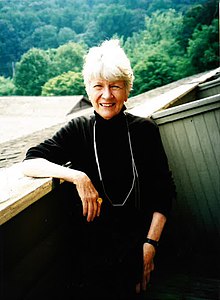The Maryland Institute College of Art (MICA) is a private art and design college in Baltimore, Maryland. Founded in 1826 as the Maryland Institute for the Promotion of the Mechanic Arts, it is regarded as one of the oldest art colleges in the United States.

Art jewelry is one of the names given to jewelry created by studio craftspeople. As the name suggests, art jewelry emphasizes creative expression and design, and is characterized by the use of a variety of materials, often commonplace or of low economic value. In this sense, it forms a counterbalance to the use of "precious materials" in conventional or fine jewelry, where the value of the object is tied to the value of the materials from which it is made. Art jewelry is related to studio craft in other media such as glass, wood, plastics and clay; it shares beliefs and values, education and training, circumstances of production, and networks of distribution and publicity with the wider field of studio craft. Art jewelry also has links to fine art and design.

Ellen Lupton is a graphic designer, curator, writer, critic, and educator. Known for her love of typography, Lupton is the Betty Cooke and William O. Steinmetz Design Chair at Maryland Institute College of Art. Previously she was the Senior Curator of Contemporary Design at Cooper Hewitt, Smithsonian Design Museum in New York City and was named Curator Emerita after 30 years of service. She is the founding director of the Graphic Design M.F.A. degree program at Maryland Institute College of Art (MICA), where she also serves as director of the Center for Design Thinking. She has written numerous books on graphic design for a variety of audiences. She has contributed to several publications, including Print, Eye, I.D., Metropolis, and The New York Times.

Mary Lee Hu is an American artist, goldsmith, and college level educator known for using textile techniques to create intricate woven wire jewelry.
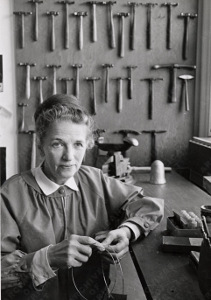
Margret Craver was an American artist and arts educator. She was noted for her jewelry and holloware as well as her educational and technical manuals on metalwork.

Joyce J. Scott is an African-American artist, sculptor, quilter, performance artist, installation artist, print-maker, lecturer and educator. Named a MacArthur Fellow in 2016, and a Smithsonian Visionary Artist in 2019, Scott is best known for her figurative sculptures and jewelry using free form, off-loom beadweaving techniques, similar to a peyote stitch. Each piece is often constructed using thousands of glass seed beads or pony beads, and sometimes other found objects or materials such as glass, quilting and leather. In 2018, she was hailed for working in new medium — a mixture of soil, clay, straw, and cement — for a sculpture meant to disintegrate and return to the earth. Scott is influenced by a variety of diverse cultures, including Native American and African traditions, Mexican, Czech, and Russian beadwork, illustration and comic books, and pop culture.

June Schwarcz was an American enamel artist who created tactile, expressive objects by applying technical mastery of her medium to vessel forms and plaques, which she considers non-functional sculpture.
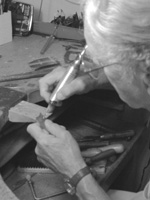
George Brooks was a Czechoslovak-born American jeweller. He was one of the first designers and fabricators of modernist and wearable art jewelry in Canada, and later relocated to Santa Barbara, California.

Marianne Strengell was an influential Finnish-American Modernist textile designer in the twentieth century. Strengell was a professor at Cranbrook Academy of Art from 1937 to 1942, and she served as department head from 1942 to 1962. She was able to translate hand-woven patterns for mechanized production, and pioneered the use of synthetic fibers.
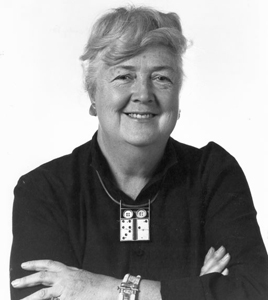
Ramona Solberg (1921–2005) created eccentric yet familiar jewelry using found objects; she was an influential teacher at the University of Washington School of Art and is often referred to as the "grandmother of Northwest found-art jewelry". Additionally, she served as an art instructor and a prolific jewelry artist in and around Seattle for three decades.

Arthur George "Art" Smith (1917–1982) was one of the leading modernist jewelers of the mid-20th century, and one of the few Afro-Caribbean people working in the field to reach international recognition. He trained at Cooper Union, NYU, and under Winifred Mason.

Helena Hernmarck is a Swedish tapestry artist who lives and works in the United States. She is best known for her monumental tapestries designed for architectural settings.
Lauren Kalman is a contemporary American visual artist who uses photography, sculpture, jewelry, craft objects, performance, and installation. Kalman's works investigate ideas of beauty, body image, and consumer culture. Kalman has taught at institutions including Brown University and the Rhode Island School of Design. Currently she is an associate professor at Wayne State University.

Josefine Pola Stout was an American designer best known for creating fine woolen fabrics. Born in Stryj, she studied with Josef Hoffmann at the Kunstgewerbe Schule in Vienna, and designed for the Wiener Werkstätte before she immigrated to the United States in 1925 with her first husband, architect and designer Wolfgang Hoffmann. Wolfgang and Pola Hoffmann became a prominent interior design team that contributed to the development of American modernism in the early 20th century. They dissolved their successful partnership in 1932, when she married popular mystery author Rex Stout. Pola Stout was an influential textile designer after her second marriage. She was executor of Rex Stout's literary estate after her husband's death in 1975.

Florence Lisa Resnikoff was an American artist and educator in the fields of metals and jewelry.
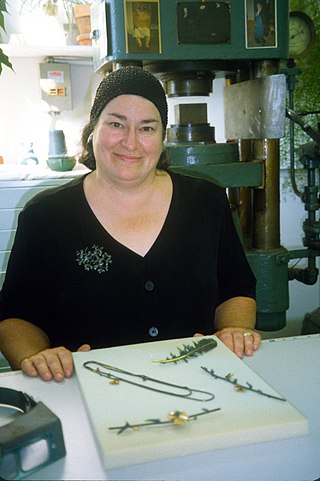
Jan Yager is an American artist who makes mixed media jewelry. She draws inspiration from both the natural world and the lived-in human environment of her neighborhood in Philadelphia, Pennsylvania, emphasizing that art is a reflection of both time and place. She has incorporated rocks, bullet casings, and crack cocaine vials into her works, and finds beauty in the resilience of urban plants that some would consider weeds.
Merle Newport Boyer was an American modernist studio art jeweler and sculptor, as well as inventor, machinist, teacher and mentor.

Cheryl D. Holmes Miller is an American graphic designer, Christian minister, writer, artist, theologian, and decolonizing historian. She is known for her contributions to racial and gender equality in the graphic design field, and establishing one of the first black-women-owned design firms in New York City in 1984. Her alma maters are the Maryland Institute College of Art, Pratt Institute, Rhode Island School of Design, and Union Theological.

Merry Renk, also known as Merry Renk-Curtis, was an American jewelry designer, metalsmith, sculptor and painter. In 1951, she helped to found the Metal Arts Guild (MAG), and served as its president in 1954.
Charles Robert Winston (1915–2003) was an American jeweler, sculptor, and educator. He was known for his organic forms and sculptural jewelry in 1950s and 1960s. Winston was a co-founder of the Metal Arts Guild of San Francisco, a non-profit, arts educational organization. In 1997, he was honored as a Fellow of the American Craft Council.
